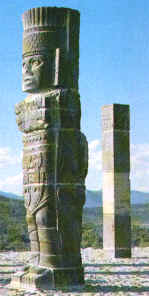|
|
Astronomy was very important to Mayas. They constructed special buildings for observing stars, such as Caracol at Chichen Itza and Group E at Uaxactun.
From these they noted the appearance and disappearance of celestial bodies in different seasons. They recorded annual cycle of the sun as 365 days and also the lunar cycle with only small margin of error.
They drew up tables for solar eclipses that would occur in a period of 33 years, calculating cycles of Mars, Jupiter and Saturn. They also plotted the movement of certain constellations such as Pleiades, which they called Tzab (serpent's rattle) and Gemini or Ac (turtle).
They used this knowledge to create two calendars. One was the solar, called Haab, with 365 days, divided into 18 months of 20 days, each plus 5 extra ones named Uayeb. The other was the ritual calendar or Tzolkin of 260 days, designated by 20 signs and 13 numbers, which was used to determine festivals of gods and predict human destinies.
Generally the two were combined, and Mayas recorded the same date in both Tzolkin and Haab.
To fix a date in certain year, there was new combination, and 18980 days would have to go by before the combination was repeated, i.e. 52 solar years and 73 ritual years. Mayanists have named this calendar "Calendar Round".

|
|

